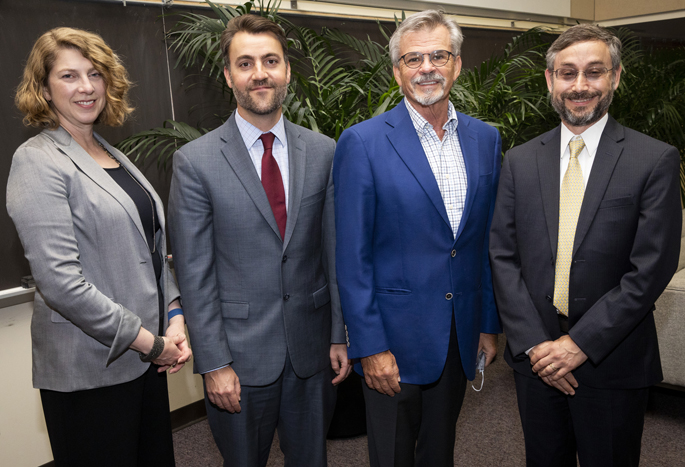
A panel of experts on opioid use disorder (OUD) discussed the importance of building recovery ecosystems or networks of resources to respond to the opioid epidemic during the recent Department of Health Policy’s Research into Policy & Practice Lecture at Vanderbilt University Medical Center.
The panel included Ernie Fletcher, MD, former governor of Kentucky and co-founder of the Fletcher Group; Michael Meit, MPH, co-director of the Center for Rural Health Research at East Tennessee State University; and Stephen Patrick, MD, MPH, executive director of Firefly and director of the Vanderbilt Center for Child Health Policy. Melinda Buntin, PhD, Mike Curb Professor and chair of the Department of Health Policy, moderated the event.
In 2021, the number of fatal opioid overdoses in the United States reached an estimated 110,000 — one death every five minutes — according to recent statistics from the Centers for Disease Control and Prevention, and the panel members agreed that a continued emphasis on criminalization, with incarceration of individuals with opioid use disorder, is not the best path forward.
“Overall, our effort is failing, unless you want to say more than 100,000 overdoses is success, and I don’t think we want to do that,” said Fletcher. “What we do is go into communities and try to build a recovery ecosystem by bringing the stakeholders together.”
While Fletcher was governor of Kentucky, he supported the establishment of Recovery Kentucky, a multiagency, social-recovery model of assisting individuals with substance abuse disorders. The program uses U.S. Department of Housing and Urban Development money to fund recovery facilities. When individuals are sent to receive treatment rather than being incarcerated, the program receives per diem funds from correction facilities to fund their housing,
By using a participant’s Supplemental Nutrition Assistance Program (SNAP) benefits and Medicare or Medicaid benefits, Recovery Kentucky funds their treatment. There are now 18 Recovery Kentucky centers providing housing and recovery services at no cost to the individual to up to 3,000 Kentuckians.
In 2017, Fletcher co-founded the Fletcher Group, a not-for-profit organization which assists and supports rural communities as they establish recovery housing and other resources for individuals with substance use disorders. Rather than incarcerating individuals, Fletcher believes it is better to connect them to a recovery ecosystem so they can reclaim a healthier, productive life.
The Rural Recovery Ecosystems Index, a collaborative project of the Center for Rural Health Research at ETSU and the Fletcher Group, will go live later this month. The index combines a group of indicators to measure the strength of rural, county-level substance use disorder recovery ecosystems using data including substance use disorder treatment facilities per capita, the distance to medication-assisted treatment providers, the presence of a drug court and the presence of supportive state policies.
The index’s map-linked data can be used to support community planning, programming and technical assistance to strengthen recovery ecosystems. When the Rural Recovery Ecosystem Index’s map of the United States was fully populated with data, Meit and others at ETSU spotted some unforeseen revelations.
“One of the things you’ll notice – and it was not quite what we expected, but it made sense as we started to unpack it – the areas that have been hardest hit by the opioid crisis tend to have the strongest recovery systems,” Meit said. “That’s because they had a lot of people to support, and they built those systems. What we want to do next with this is to identify those areas that have a lot of substance abuse but a low recovery ecosystem score because those are the areas where we need to provide technical assistance.”
Patrick then presented a current snapshot of substance abuse disorder and its impact on pregnant and postpartum women and newborn children.
“Overdose is the leading cause of pregnancy-related deaths in Tennessee; it’s a substantial problem that our families are facing,” he said. “Overdose is kind of the tip of the iceberg. Opioid use disorder in pregnancy and opioid-related diagnoses have doubled since 2010. Rates of neonatal abstinence syndrome or neonatal opioid withdrawal syndrome have grown by about sevenfold since 2000 … and infants are the fastest growing population in the foster care system, with most of them there due to parental substance abuse.”
Firefly, which Patrick directs, is a program at VUMC that combines prenatal and postpartum care with treatment for OUD for women facing the dual challenge of pregnancy and recovery in Middle Tennessee. The program is a partnership between VUMC, TennCare and the Centers for Medicare and Medicaid Services and is free for eligible women. Since Firefly was launched in 2021, 150 patients have been enrolled.
Firefly pairs participants with a peer recovery specialist who has their own lived experience, it brings together all needed clinical support in one location, patients are followed until one year postpartum, and Firefly partners with community-based programs which can further support the patient’s continued recovery.
“The lecture was designed to showcase evidence-based ways to improve outcomes and give hope to individuals and communities struggling with substance abuse disorder,” Buntin said. “The feedback we received from attendees is that they are going to take these ideas back to their practices and to policymakers.”












